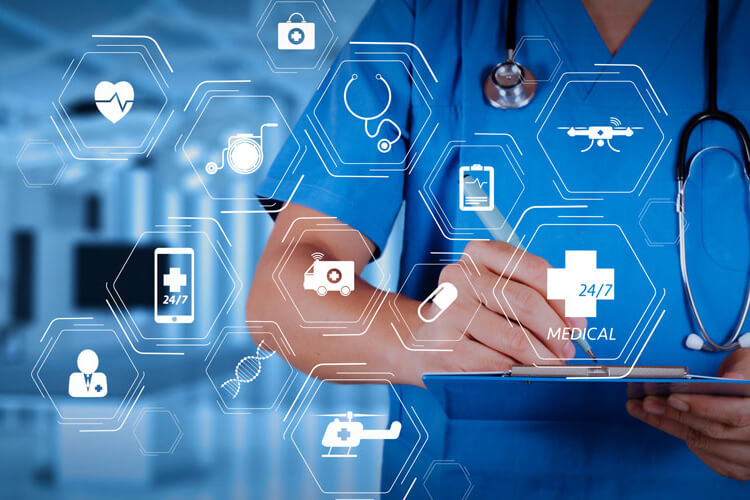-
Table of Contents
“Empowering healthcare through Edge Computing and Wearable Technology.”
Edge computing and wearable technology are two rapidly evolving fields that are shaping the future of healthcare. Edge computing refers to the practice of processing and analyzing data at or near the source of generation, rather than relying on a centralized cloud infrastructure. This approach enables real-time data processing, reduced latency, and improved privacy and security. On the other hand, wearable technology encompasses a wide range of devices that can be worn on the body, such as smartwatches, fitness trackers, and biosensors. These devices collect and transmit valuable health data, allowing for continuous monitoring and personalized healthcare interventions. Together, edge computing and wearable technology hold immense potential to revolutionize healthcare by enabling remote patient monitoring, early disease detection, personalized treatment plans, and improved patient outcomes.
The Role of Edge Computing in Revolutionizing Healthcare with Wearable Technology
Edge Computing and Wearable Technology: Shaping the Future of Healthcare
The healthcare industry has always been at the forefront of technological advancements, constantly seeking innovative solutions to improve patient care and outcomes. In recent years, the convergence of edge computing and wearable technology has emerged as a game-changer in revolutionizing healthcare. This article explores the role of edge computing in shaping the future of healthcare with wearable technology.
Wearable technology, such as smartwatches, fitness trackers, and biosensors, has gained significant popularity among consumers. These devices are equipped with sensors that can monitor various health parameters, including heart rate, blood pressure, sleep patterns, and physical activity. The data collected by these wearables can provide valuable insights into an individual’s health and well-being.
However, the true potential of wearable technology lies in its ability to seamlessly integrate with edge computing. Edge computing refers to the decentralized processing of data at the edge of the network, closer to the source of data generation. By processing data locally, at the device level, edge computing reduces latency and enables real-time analysis and decision-making.
In the context of healthcare, edge computing allows wearable devices to process and analyze health data in real-time, without relying on a centralized cloud infrastructure. This is particularly crucial in situations where immediate action is required, such as detecting abnormal heart rhythms or monitoring glucose levels in diabetic patients. By leveraging edge computing, wearable devices can provide timely alerts and notifications to both patients and healthcare providers, enabling proactive interventions and potentially saving lives.
Moreover, edge computing also addresses the issue of data privacy and security. With the increasing concerns surrounding the unauthorized access and misuse of personal health information, edge computing ensures that sensitive data remains within the confines of the device itself. This decentralized approach minimizes the risk of data breaches and enhances patient confidentiality, instilling trust in wearable technology as a reliable healthcare tool.
Furthermore, the integration of edge computing and wearable technology opens up new possibilities for remote patient monitoring and telemedicine. Patients can now receive continuous healthcare monitoring and support from the comfort of their homes, reducing the need for frequent hospital visits. Healthcare providers can remotely access real-time patient data, enabling them to make informed decisions and provide personalized care, even from a distance.
Additionally, the combination of edge computing and wearable technology has the potential to revolutionize clinical research and drug development. By collecting vast amounts of real-world patient data, researchers can gain valuable insights into disease patterns, treatment effectiveness, and adverse events. This data-driven approach can accelerate the discovery and development of new therapies, ultimately benefiting patients worldwide.
In conclusion, edge computing and wearable technology are shaping the future of healthcare by revolutionizing patient care, data analysis, and research. The integration of edge computing with wearable devices enables real-time monitoring, proactive interventions, and remote patient management. It also addresses concerns regarding data privacy and security, fostering trust in wearable technology as a reliable healthcare tool. As we continue to embrace technological advancements, the potential for edge computing and wearable technology to transform healthcare is immense. The future of healthcare is undoubtedly being shaped by the convergence of these two powerful technologies.
Exploring the Potential of Edge Computing and Wearable Technology in Remote Patient Monitoring
Edge Computing and Wearable Technology: Shaping the Future of Healthcare
Exploring the Potential of Edge Computing and Wearable Technology in Remote Patient Monitoring
In recent years, the healthcare industry has witnessed a significant transformation with the advent of edge computing and wearable technology. These technological advancements have revolutionized the way healthcare professionals monitor and care for their patients, particularly in remote patient monitoring. By combining the power of edge computing and wearable devices, healthcare providers can now gather real-time data, analyze it, and make informed decisions promptly.
Edge computing, a decentralized computing infrastructure, brings computation and data storage closer to the source of data generation. This means that instead of relying on a centralized cloud server, data processing and analysis can occur at the edge of the network, closer to the patient. This has numerous advantages, especially in remote patient monitoring scenarios where immediate action is crucial.
Wearable technology, on the other hand, refers to devices that can be worn on the body, such as smartwatches, fitness trackers, and even smart clothing. These devices are equipped with sensors that can collect various health-related data, including heart rate, blood pressure, sleep patterns, and even body temperature. By continuously monitoring these vital signs, healthcare professionals can gain valuable insights into a patient’s health status and detect any abnormalities or potential risks.
The combination of edge computing and wearable technology has opened up a world of possibilities in remote patient monitoring. With the ability to collect real-time data from wearable devices, healthcare providers can monitor patients’ health conditions without the need for frequent in-person visits. This is particularly beneficial for patients with chronic conditions or those who live in remote areas where access to healthcare facilities is limited.
One of the key advantages of edge computing in remote patient monitoring is the reduced latency in data processing. Since data is processed locally, there is no need to send it to a centralized server for analysis. This means that healthcare professionals can receive real-time updates on a patient’s health status, allowing for immediate intervention if necessary. For example, if a patient’s heart rate suddenly spikes, an alert can be sent to the healthcare provider, who can then take appropriate action to prevent any potential complications.
Furthermore, edge computing enables the integration of artificial intelligence (AI) algorithms into wearable devices. This means that wearable devices can not only collect data but also analyze it in real-time. AI algorithms can detect patterns and anomalies in the data, providing healthcare professionals with valuable insights and predictive analytics. For instance, AI algorithms can identify early signs of a heart attack based on changes in heart rate and blood pressure, allowing for timely intervention and potentially saving lives.
In addition to real-time monitoring and analysis, edge computing also ensures data privacy and security. Since data is processed locally, there is no need to transmit sensitive patient information to a centralized server. This reduces the risk of data breaches and unauthorized access. Healthcare providers can rest assured that patient data is protected and comply with strict privacy regulations.
In conclusion, the combination of edge computing and wearable technology has immense potential in shaping the future of healthcare, particularly in remote patient monitoring. The ability to collect real-time data, analyze it locally, and make informed decisions promptly has revolutionized the way healthcare professionals care for their patients. With reduced latency, integration of AI algorithms, and enhanced data privacy and security, edge computing and wearable technology are paving the way for a more efficient and effective healthcare system. As technology continues to advance, we can expect even more innovative solutions that will further improve patient outcomes and revolutionize the healthcare industry as a whole.
Enhancing Healthcare Efficiency and Patient Outcomes through Edge Computing and Wearable Technology
Edge Computing and Wearable Technology: Shaping the Future of Healthcare
In recent years, the healthcare industry has witnessed a significant transformation with the advent of edge computing and wearable technology. These technological advancements have revolutionized the way healthcare is delivered, enhancing efficiency and improving patient outcomes. By seamlessly integrating edge computing and wearable devices, healthcare providers can now monitor patients in real-time, collect valuable data, and make informed decisions promptly.
One of the key benefits of edge computing in healthcare is its ability to process data locally, at the edge of the network, rather than relying on a centralized cloud infrastructure. This enables healthcare providers to analyze data in real-time, reducing latency and ensuring timely interventions. With the increasing popularity of wearable devices, such as smartwatches and fitness trackers, patients can now monitor their vital signs, activity levels, and even detect potential health issues at an early stage.
Wearable technology has become an integral part of healthcare, empowering individuals to take control of their own health. These devices can track various health parameters, including heart rate, blood pressure, sleep patterns, and even stress levels. By continuously monitoring these metrics, individuals can make informed decisions about their lifestyle choices and seek medical attention when necessary. This proactive approach to healthcare not only improves patient outcomes but also reduces the burden on healthcare systems.
Moreover, wearable devices equipped with sensors can provide real-time data to healthcare professionals, enabling remote patient monitoring. This is particularly beneficial for patients with chronic conditions or those who require regular check-ups. By remotely monitoring patients, healthcare providers can detect any abnormalities or deviations from the norm and intervene promptly. This not only saves time and resources but also ensures that patients receive timely care, even from the comfort of their own homes.
The integration of edge computing and wearable technology also holds great promise for telemedicine. Telemedicine allows healthcare professionals to provide virtual consultations and remote diagnosis, eliminating the need for in-person visits. By leveraging wearable devices, healthcare providers can gather vital data during these virtual consultations, enabling them to make accurate diagnoses and prescribe appropriate treatments. This not only improves access to healthcare, especially for individuals in remote areas, but also reduces the risk of exposure to contagious diseases.
Furthermore, the data collected from wearable devices can be analyzed using artificial intelligence (AI) algorithms, providing valuable insights for personalized medicine. AI algorithms can identify patterns and correlations in the data, enabling healthcare providers to tailor treatment plans to individual patients. This precision medicine approach ensures that patients receive the most effective treatments, minimizing side effects and improving overall outcomes.
In conclusion, the integration of edge computing and wearable technology is revolutionizing the healthcare industry. By leveraging these advancements, healthcare providers can enhance efficiency, improve patient outcomes, and promote proactive healthcare. The ability to monitor patients in real-time, remotely diagnose and treat individuals, and personalize medicine based on data insights is shaping the future of healthcare. As technology continues to evolve, we can expect further advancements in edge computing and wearable technology, leading to even greater improvements in healthcare delivery.In conclusion, edge computing and wearable technology are playing a significant role in shaping the future of healthcare. These technologies offer real-time data processing and analysis, enabling healthcare professionals to make faster and more accurate diagnoses and treatment decisions. Wearable devices provide continuous monitoring of vital signs and health parameters, allowing for proactive and personalized healthcare interventions. The combination of edge computing and wearable technology has the potential to revolutionize healthcare delivery, improving patient outcomes and reducing healthcare costs.





